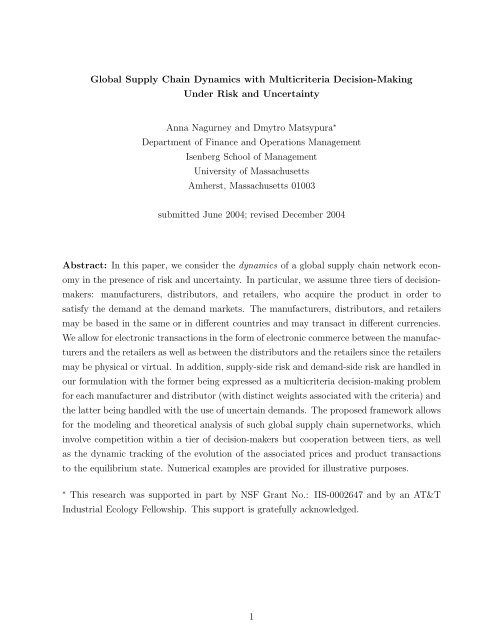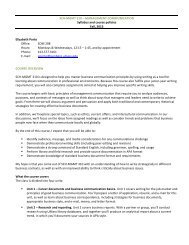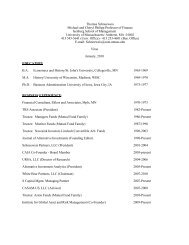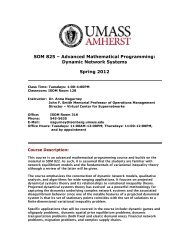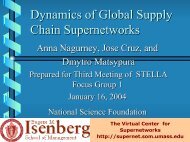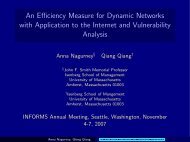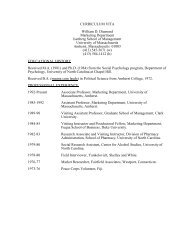Global Supply Chain Dynamics with Multicriteria Decision-Making ...
Global Supply Chain Dynamics with Multicriteria Decision-Making ...
Global Supply Chain Dynamics with Multicriteria Decision-Making ...
Create successful ePaper yourself
Turn your PDF publications into a flip-book with our unique Google optimized e-Paper software.
<strong>Global</strong> <strong>Supply</strong> <strong>Chain</strong> <strong>Dynamics</strong> <strong>with</strong> <strong>Multicriteria</strong> <strong>Decision</strong>-<strong>Making</strong>Under Risk and UncertaintyAnna Nagurney and Dmytro Matsypura ∗Department of Finance and Operations ManagementIsenberg School of ManagementUniversity of MassachusettsAmherst, Massachusetts 01003submitted June 2004; revised December 2004Abstract: In this paper, we consider the dynamics of a global supply chain network economyin the presence of risk and uncertainty. In particular, we assume three tiers of decisionmakers:manufacturers, distributors, and retailers, who acquire the product in order tosatisfy the demand at the demand markets. The manufacturers, distributors, and retailersmay be based in the same or in different countries and may transact in different currencies.We allow for electronic transactions in the form of electronic commerce between the manufacturersand the retailers as well as between the distributors and the retailers since the retailersmay be physical or virtual. In addition, supply-side risk and demand-side risk are handled inour formulation <strong>with</strong> the former being expressed as a multicriteria decision-making problemfor each manufacturer and distributor (<strong>with</strong> distinct weights associated <strong>with</strong> the criteria) andthe latter being handled <strong>with</strong> the use of uncertain demands. The proposed framework allowsfor the modeling and theoretical analysis of such global supply chain supernetworks, whichinvolve competition <strong>with</strong>in a tier of decision-makers but cooperation between tiers, as wellas the dynamic tracking of the evolution of the associated prices and product transactionsto the equilibrium state. Numerical examples are provided for illustrative purposes.∗ This research was supported in part by NSF Grant No.: IIS-0002647 and by an AT&TIndustrial Ecology Fellowship. This support is gratefully acknowledged.1
1. IntroductionFewer than ten years ago, the purchase of a product, typically, involved getting dressed,using some mode of transport to reach the shopping destination, selecting the product physically,and then paying for the purchase. Today, many consumers, be they at home, at work,or at some other location, can go online 24 hours a day, 7 days a week, and select and purchasea great assortment of products over the Internet while doing their “shopping.” Indeed,it is now possible, in many instances, to buy books, videos, and CDs online as well as toorder food from a supermarket or retaurant in an electronic manner, and have the itemsdelivered afterwards to the desired destination.The revolution in electronic commerce has affected not only consumers and their decisionmakingbut has also influenced the producers/manufacturers, the distributors, as well asthe retailers (be they physical or virtual), and, in effect, the entire product supply chain.According to Salkever (2003), Intel, one of the world’s largest computer chip manufacturers,last year generated 85% of its orders – some $22.8 billion worth – online. Moreover, 26% ofthe sales occurred after the company’s physical offices had closed for the day. Furthermore,Intel estimates that it saved $500 million in the year 2002 due to greater control over thesupplies that it requires for chip manufacture.Indeed, both business-to-consumer (B2C) commerce and business-to-business (B2B) commercevia the Internet are thriving. For example, in Europe alone, the amount of goods andservices purchased online by companies in 2002 surpassed $200 billion (cf. BusinessWeek(2003)), resulting in a 100% growth in the number of transactions, <strong>with</strong> B2C commerce inEurope growing at an annual rate of 75%.The advent of electronic commerce is enabling the world to move closer to the realizationof a single, borderless market and is driving the increasing globalization of not only businessesbut also supply chains. At the same time, however, increasing globalization exposes supplychains to new risks and uncertainties. For example, recently, the threat of illness in theform of SARS (see Engardio et al. (2003)) disrupted supply chains as have terrorist threatsand wars (see Sheffi (2001)). Frameworks for risk management in a global supply chaincontext <strong>with</strong> a focus on centralized decision-making and optimization have been proposedby Huchzermeier and Cohen (1996), Cohen and Mallik (1997), and Cohen and Huchzermeier(1998) (see also the references therein). Nagurney, Cruz, and Dong (2003), in turn, proposeda global supply chain model <strong>with</strong> both supply-side risk (handled as multicriteria decisionmakingproblems) and demand-side risk (formulated through the use of random demands).Moreover, they allowed for competition across a tier of decision-makers but cooperation2
etween tiers in the supply chain network. Although the importance of global issues insupply chain management and analysis has been emphasized in several papers (cf. Kogutand Kulatilaka (1994), Cohen and Malik (1997), Nagurney, Cruz, and Matsypura (2003)),the topic of supply chain risk modeling is fairly new and requires novel methodologicalapproaches that are able to capture the operational as well as the financial aspects of suchdecision-making.In addition, it is imperative to be able to address dynamic issues since the not only doesthe speed of the Internet allow for transactions to be conducted across the globe but suchtransactions can occur very rapidly. Moreover, it is important to recognize and capturedistinct speeds associated <strong>with</strong> the decision-makers’ transactions. In 1939, Hicks in hisclassic work took the first steps towards the integration of comparative statics and dynamiceconomics. Samuelson (1941), sbsequently, in a pioneering article presented the first completesynthesis of dynamics and comparative statics and demonstrated the importance of dynamiceconomics in the analysis of equilibrium. In these publications, as well as in numerous studiesthat followed (see, e.g., Metzler (1945), Arrow and Hurwicz (1958), Quandt (1967), Hahn(1970), and Okuguchi (1976)), there was one natural and, yet very important, assumptionmade: a change in price is proportional to the difference between the demand and the supplyof the product. Fisher offered a similar adjustment assumption for the individual outputs(Fisher (1961)) and suggested that it might have interesting consequences for the discussionof stability.In this paper, we build upon the ideas of classical economics in terms of dynamics byproposing a dynamic global supply chain network model which includes explicit speeds of adjustment,which are incorporated into a projected dynamical systems formalism (cf. Dupuosand Nagurney (1993), Zhang and Nagurney (1995), and Nagurney and Zhang (1996)) forthe first time. We also establish some entirely new theoretical results. In addition, ourmotivation for this research also stems from the need to include dynamics into the modeling,analysis, and solution of global supply chains in the presence of electronic commerce and inthe new era of risk and uncertainty. Hence, building also on the contributions of Nagurney,Cruz, and Dong (2003) and that of Nagurney, Cruz, and Matsypura (2003), our dynamicglobal supply chain network model also captures decision-making under risk and uncertaintyassociated <strong>with</strong> both the supply-side as well as the demand-side.In particular, in this paper, we focus on the development of a dynamic global supply chainsupernetwork model <strong>with</strong> supply-side and demand-side risk that considers the interactionsamong three distinct tiers of decision-makers, notably, the manufacturers, the distributors,3
as well as the retailers, who must respond to the consumers as represented by the associateddemand functions for the product. The speeds of adjustment may be distinct for each transactionthat takes place. The general framework that we utilize is that of supernetworks, asintroduced by Nagurney and Dong (2002) to capture the trade-offs associated <strong>with</strong> decisionmakingon transportation versus telecommunication networks in the Information Age. Ithas recently been applied to construct a single country supply chain network model <strong>with</strong>electronic commerce by Nagurney et al. (2002) (see also, e.g., Nagurney et al. (2002a))and to model financial decision-making <strong>with</strong> intermediaries and electronic transactions in,respectively, a single-country and international context by Nagurney and Ke (2003) andNagurney and Cruz (2003).This paper is organized as follows. In Section 2, we develop the global supply chain supernetworkmodel and derive its projected dynamical system formulation (see also Nagurney andZhang (1996) and Nagurney and Dong (2002)). The projected dynamical system describeshow the product transactions evolve through time between the tiers of the supernetworkas well as how the prices associated <strong>with</strong> the retailers and the distributors evolve. Wealso establish that the set of stationary points of the projected dynamical system coincides<strong>with</strong> the set of equilibrium points (formulated as a variational inequality problem) of theglobal supply chain network model of Nagurney, Cruz, and Dong (2003). In the samesection we provide some theoretical properties of the projected dynamical system. In Section3, we propose an algorithm, which provides a time discretization of the continuous timetrajectories of the product shipments and prices. In Section 4, we apply the algorithm toseveral numerical global supply chain network examples. We conclude the paper <strong>with</strong> asummary and discussion in Section 5.4
2. The Dynamic <strong>Global</strong> <strong>Supply</strong> <strong>Chain</strong> Network Model <strong>with</strong> Risk and UncertaintyIn this Section, we develop the dynamic global supply chain network model in whichphysical and electronic transactions are allowed and in which both supply-side and demandsiderisks are included. In particular, we consider (cf. Figure 1) a three tiered supply chainnetwork consisting of: manufacturers, distributors, and retailers, and these are associated,respectively, <strong>with</strong> the top tier, the middle tier, and the bottom tier of nodes of the network.Both the manufacturers and the distributors are assumed to be multicriteria decision-makersand concerned not only <strong>with</strong> profit maximization but also <strong>with</strong> risk minimization. The risksthat manufacturers and distributors face may include, for example, the political risk, thecurrency risk, or a combination thereof, etc. The bottom tier of decision-makers, namely,the retailers, in turn, are faced <strong>with</strong> the risk associated <strong>with</strong> the uncertainty in demands.We consider a global setting, in which there are L countries, <strong>with</strong> a typical countrydenoted by l, ˆl, or¯l (since we need to distinguish a given country by tier). There are Imanufacturers in each country <strong>with</strong> a typical manufacturer i in country l denoted by il andassociated <strong>with</strong> node il in the top tier of nodes in the global supply chain supernetwork(cf. Figure 1). There are, hence, a total of IL manufacturers in the global economy. Also,we consider J distributors in each country <strong>with</strong> a typical distributor j in country ˆl beingdenoted by jˆl and associated <strong>with</strong> the second tier node jˆl in the network. There are, thus, atotal of JL distributors in the global supply chain network. A typical retailer k in country¯l dealing in currency h is denoted by kh¯l and is associated <strong>with</strong> the corresponding nodein the bottom tier of the network and is, referred to, henceforth, as retailer kh¯l, <strong>with</strong> theunderstanding that the retailer is associated <strong>with</strong> a country and transactions in a currency.There are a total of KHL bottom tiered nodes in the global supply chain <strong>with</strong> K denotingthe number of retailers and H the number of currencies.In order to more clearly understand the processes that drive the dynamics of the proposedsystem, we assume a homogeneous product economy meaning that the same product isbeing produced by all manufacturers, shipped to the distributors, who, in turn, distributethe product to the retailers. We allow the manufacturers to transact either physically <strong>with</strong>the distributors, or directly, in an electronic manner, <strong>with</strong> the retailers, which reflects thedevelopment and popularization of the electronic mode of doing business in today’s economy.Therefore, the links connecting the top and the bottom tiers of nodes in Figure 1 representelectronic links. The retailers associated <strong>with</strong> the bottom tier of nodes of the global supplychain network may not necessarily be physical. They may represent on-line stores or otherkinds of virtual retailers. The framework can also handle multiple products, but <strong>with</strong> a5
concommitant increase in notation.Note that in Figure 1, there are H distinct links between a manufacturer and a distributorpair. For example, the h-th link connecting manufacturer il <strong>with</strong> distributor jˆl denotes thepossibility of a transaction between this pair of decision-makers in currency h. The flowon such a link, hence, is the volume of product transacted between this pair in currency h<strong>with</strong> the flow denoted by q il . We group all such flows for all the manufacturers (in all thejhˆlcountries) and transacting <strong>with</strong> all the distributors (in all the countries) via the currenciesinto the column vector Q 1 ∈ R+ ILJHL . In addition, we note that there is a single linkconnecting each manufacturer il <strong>with</strong> each bottom tiered node in the network in Figure 1and denote the volume of product transacted between il and retailer kh¯l by q ilkh¯l. Such linksdenote transactions conducted electronically. We group all the product flows between themanufacturers and the retailers into the column vector Q 2 ∈ R+ ILKHL .Finally, note that the links connecting the distributors <strong>with</strong> the retailers reflect transactionsconducted in a specific currency since the bottom tiered nodes denote retailer/currency/country combinations, and the flow on such an abstract link denotes the volume of producttransacted in such a fashion between the manufacturer and retailer pair. Since we allowretailers to be either physical or virtual the link between a distributor and retailer pair maycorrespond to a physical transaction or to an electronic transaction. We let q jˆl denote thekh¯lvolume of product transacted electronically between distributor jˆl in currency h <strong>with</strong> retailerk in country ¯l and group all such flows into the column vector Q 3 ∈ R+ JLKHL .We now turn to the description of the dynamic adjustment processes which govern thedisequilibrium dynamics as the various global supply chain decision-makers adjust theirproduct transactions between the tiers and the prices associated <strong>with</strong> the different tiersadjust as well. We begin <strong>with</strong> a discussion of the price dynamics and then describe thedynamics of the product transactions.6
Country 1 Country l Country LManufacturers Manufacturers Manufacturers♠ ♠ ♠ ♠ ♠ ♠11 ··· I1 ··· 1l ··· Il ··· 1L ··· IL1···H ··· ··· ··· ··· 1···HCurrenciesDistributors 11 ♠··· jˆl ♠ ··· JL♠❛❅ ❛❛❛❛❛❛❛❛❛❛❛❛❛❛❛❛❛✑❍ ✑ ❆❆❆❆❆❆ ❍❍❍❍❍❍❍❍❍❍❍❍❍ ❆ ✑ ❅❅❅❅❅❅ ❆❆❆❆❆ ✑✑ ✑ ✑✑✏✮✏ ✏✏✏✏✏✏✏✏✏✏✏✏✏✏✏✏✏✏✏✏✑✑✑✰ ✠❅❘ ❆❯ ✠❍❥ ❆❯111 ♠ ··· kh¯l♠ ··· KHL ♠RetailersFigure 1: The Structure of the <strong>Global</strong> <strong>Supply</strong> <strong>Chain</strong> SupernetworkThe Retail Price <strong>Dynamics</strong>We begin by describing the dynamics underlying the prices of the product associated <strong>with</strong> theretailers since the demand for the product drives both the manufacture and the distributionof the product. Let ρ 3kh¯l denote the price of the product associated <strong>with</strong> retailer kh¯l. Weassume that ˆd kh¯l(ρ 3kh¯l) is the demand for the product at the price ρ 3kh¯l at retailer kh¯l, whereˆd kh¯l(ρ 3kh¯l) isarandom variable <strong>with</strong> density function F kh¯l(x, ρ 3kh¯l), <strong>with</strong> ρ 3kh¯l serving as aparameter. Hence, we assume that the density function may vary <strong>with</strong> the retailer price. LetP kh¯l be the probability distribution function of ˆd kh¯l(ρ 3kh¯l), that is, P kh¯l(x, ρ 3kh¯l) =P kh¯l( ˆd kh¯l ≤x) = ∫ x0 F kh¯l(x, ρ 3kh¯l)dx. See also the discussion in Dong, Zhang, and Nagurney (2002, 2003)and Nagurney, Cruz, and Matsypura (2003).Using the most natural and popular among economists assumption about the forces thatinfluence the behavior of the prices in the market economy (see, for example, Samuelson(1941), Metzler (1945), and Arrow and Hurwicz (1958)), we assume that the rate of changeof the price ρ 3kh¯l, denoted by ˙ρ 3kh¯l, is proportional to the difference between the expecteddemand, where the expected demand is d kh¯l(ρ 3kh¯l) ≡ E( ˆd kh¯l(ρ 3kh¯l)), and the total amounttransacted <strong>with</strong> the retailer. Moreover, the rate of change of the price ρ 3kh¯l has the same7
sign as the difference between the expected demand and the total amount transacted <strong>with</strong>the retailer. Let φ kh¯l denote the speed of adjustment associated <strong>with</strong> the price at demandmarket k, currency h, and country ¯l. This term or factor is assumed to be positive.Hence, we have that for each k, h, ¯l⎧ [⎪⎨ φ kh¯l d kh¯l(ρ 3kh¯l) − ∑ I ∑ Ll=1i=1 q ilkh¯l − ∑ ]J ∑ Ḽ qjˆlj=1 , if ρl=1 kh¯l3kh¯l > 0{˙ρ 3kh¯l =[⎪⎩ max 0,φ kh¯l d kh¯l(ρ 3kh¯l) − ∑ I ∑ Ll=1i=1 q ilkh¯l − ∑ ]J ∑ } Ḽ qjˆlj=1 , if ρl=1 kh¯l3kh¯l =0.(1)Note that φ kh¯l may also be interpreted as the sensitivity of the specific demand market inthe country and associated <strong>with</strong> transactions in a particular currency to the changes in thesupply and/or demand of the product.Hence, if the demand for the product at the retailer (at an instant in time) exceeds theamount available, the price of the product at that retailer will increase <strong>with</strong> the speed φ kh¯l;if the amount available exceeds the demand at the price, then the price at the retailer willdecrease <strong>with</strong> the same speed φ kh¯l. Furthermore, we guarantee that the prices do not becomenegative.The <strong>Dynamics</strong> of the Prices at the DistributorsThe prices charged for the product by various distributors must reflect supply and demandconditions, similar to the case of the retailers. We let ˙γ jˆldenote the rate of change of theprice of the product at distributor jˆl. Thus, we assume that the price for the product chargedby distributor jˆl, associated <strong>with</strong> the node jˆl in the middle tier of the supply chain network,evolves over time according to:⎧⎪⎨˙γ jˆl=⎪⎩[ ∑Kk=1 ∑φ Hh=1 ∑jˆlL¯l=1q jˆl − ∑ ]I ∑ Ll=1 ∑ Hh=1kh¯l i=1 q il , if γjhˆljˆl> 0{ [ ∑Kk=1 ∑max 0,φ Hh=1 ∑jˆlL¯l=1q jˆl − ∑ ]I ∑ Ll=1 ∑ } Hh=1kh¯l i=1 q il , if γjhˆljˆl=0.and that such dynamics hold for all the distributors jˆl. Here, the term φ jˆlis the speed ofadjustment of the price for the product at distributor jˆl. This term is also assumed to bepositive for all jˆlss.In other words, if the amount of the product desired to be transacted by the retailers(at an instant in time) exceeds that available at the distributor, then the price charged atthe distributor will increase <strong>with</strong> the speed φ jˆl;if the amount available is greater than thatdesired by the retailer, then the price charged by the distributor will decrease <strong>with</strong> the same(2)8
speed φ jˆl.As in the case of the retail prices, we guarantee that the prices charged by thedistributors remain nonnegative through the above projection operation.Precursors to the <strong>Dynamics</strong> of the Product TransactionsBefore we describe the dynamics of the product transactions, it is necessary to describe thebehavior of the first tier of decision-makers, that is, the manufacturers, and also to introducesome additional notation. Let q il denote the production output of manufacturer il, whichis a nonnegative quantity. We group the production outputs of all manufacturers into thecolumn vector q ∈ R+ IL and assume that each manufacturer il has a production cost functionf il , which can depend, in general, on the entire vector of production outputs, that is,f il = f il (q), ∀i, l. (3)Therefore, the production cost of a particular manufacturer can depend not only on hisproduction output but also on the production outputs of the other manufacturers. Thisallows one to model competition.Let c il denote the transaction cost (which we assume includes the cost of transportationjhˆland other expenses) that manufacturer il is faced <strong>with</strong> in transacting <strong>with</strong> distributor jˆl incurrency h. Let c ilkh¯l, in turn, denote the transaction cost (which also includes the cost oftransportation and other expenses) that manufacturer il is faced <strong>with</strong> transacting directly<strong>with</strong> retailer k in currency h and country ¯l. These transaction costs may depend uponthe volume of transactions between each such pair in a particular currency, and their formdepends on the type of transaction. They are given, respectively, by:andThe following conservation of flow equation must hold:J∑ H∑ L∑q il = q il + ∑ K H∑ L∑jhˆlj=1 h=1 ˆl=1 k=1 h=1c iljhˆl = cil jhˆl (qil jhˆl ), ∀i, l, j, h, ˆl (4a)c ilkh¯l = cil kh¯l (qil kh¯l ), ∀i, l, k, h, ¯l. (4b)¯l=1q ilkh¯l, ∀i, l. (5)Thus, according to (5) the amount of the product produced by a manufacturer is equal tothe amount transacted <strong>with</strong> the distributors and <strong>with</strong> the retailers in the various currencies.Note that one can express the production cost function of manufacturer il (cf. (3)) as afunction of the vectors Q 1 and Q 2 : f il (Q 1 ,Q 2 ) and we use this notation, henceforth.9
It is assumed that each manufacturer seeks to maximize his profits which is the differencebetween his revenue and the total costs incurred. The revenue is equal to the productof the price and the total quantity transacted <strong>with</strong> all the distributors and <strong>with</strong> all theretailers. Since we allow the transactions to take place in different currencies, the pricesof the product in different currencies associated <strong>with</strong> transactions <strong>with</strong> different tiers ofdecision-makers may be distinct. Let ρ il denote the price associated <strong>with</strong> the product1jhˆltransacted between manufacturer il and distributor jˆl in currency h, and let ρ il1kh¯ldenotethe price of the product associated <strong>with</strong> a transaction between manufacturer il and retailerk in currency h and country ¯l.Another assumption to be noted is that all the cost functions are given in the basecurrency. Considering the fact that the prices are in different currencies and costs are allin the base currency, we need to introduce a device that will bring all the measures to onecommon denomination. Hence, we introduce the currency appreciation rate e h , which is theappreciation rate of currency h relative to the base currency (see, e.g., Nagurney, Cruz, andMatsypura (2003) and Nagurney and Siokos (1997) for further details). Given the above,the total revenue of manufacturer il can be expressed as:J∑ H∑ L∑(ρ il + e 1jhˆl h)q il + ∑ K H∑ L∑(ρ iljhˆl 1kh¯l + e h)q ilkh¯l .j=1 h=1 ˆl=1 k=1 h=1 ¯l=1Consequently, using the conservation of flow equation (5), the production cost functions(3), and the transaction cost functions (4a) and (4b), one can express the profit maximizationcriterion for manufacturer il as:J∑ H∑ L∑Maximize(ρ il + e 1jhˆl h)q il + ∑ K H∑ L∑(ρ iljhˆl 1kh¯l + e h)q ilkh¯lj=1 h=1 ˆl=1 k=1 h=1 ¯l=1−f il (Q 1 ,Q 2 ) −J∑H∑j=1 h=1L∑c iljhˆl (qil ) − ∑ Kjhˆlˆl=1 k=1subject to: q il ≥ 0, for all j, h, ˆl and q iljhˆl kh¯l≥ 0, for all k, h, ¯l.H∑ L∑c ilkh¯l (qil kh¯l), (6)h=1 ¯l=1See, e.g., Nagurney, Cruz, and Matsypura (2003) for additional discussions.In addition to the criterion of profit maximization, we also assume that each manufactureris concerned <strong>with</strong> risk minimization. Here, for the sake of generality, we assume, as given,a risk function r il , for manufacturer i in country l, which is assumed to be continuous andconvex and a function of not only the product transactions associated <strong>with</strong> the particularmanufacturer but also of those of other manufacturers. Hence, we assume thatr il = r il (Q 1 ,Q 2 ), ∀i, l. (7)10
Note that according to (7), the risk as perceived by a manufacturer is dependent not onlyupon his product transactions but also on those of other manufacturers. Hence, the secondcriterion of manufacturer il can be expressed as:Minimize r il (Q 1 ,Q 2 ), (8)subject to: q iljhˆl ≥ 0, for all j, h, ˆl and q ilkh¯l ≥ 0, for all k, h, ¯l. The risk function may be distinctfor each manufacturer/country combination and can assume whatever form is necessary.<strong>Multicriteria</strong> <strong>Decision</strong>-<strong>Making</strong> Behavior of the ManufacturersEach manufacturer il considers the risk minimization criterion to be of a certain level ofimportance, but this level is not necessarily the same for all manufacturers. In order toemphasize this fact, we associate a nonnegative weight α il <strong>with</strong> the risk minimization criterion(8), <strong>with</strong> the weight associated <strong>with</strong> the profit maximization criterion (6) serving as thenumeraire and being set equal to 1. Thus, we can construct a value function for eachmanufacturer (cf. Fishburn (1970), Chankong and Haimes (1983), Yu (1985), Keeney andRaiffa (1993)) using a constant additive weight value function. Consequently, letting U ildenote the multicriteria objective function faced by manufacturer il, the decision-makingproblem for manufacturer il, for i =1,...,I; l =1,...,L, can be transformed into:J∑ H∑ L∑Maximize U il = (ρ il + e 1jhˆl h)q il + ∑ K H∑ L∑(ρ iljhˆl 1kh¯l + e h)q ilkh¯l¯l=1−f il (Q 1 ,Q 2 ) −J∑j=1 h=1j=1 h=1 ˆl=1H∑L∑c iljhˆl (qil ) − ∑ Kjhˆlˆl=1 k=1H∑h=1L∑k=1 h=1subject to: q il ≥ 0, for all j, h, ˆl and q iljhˆl kh¯l≥ 0, for all k, h, ¯l.¯l=1c ilkh¯l (qil kh¯l ) − αil r il (Q 1 ,Q 2 ), (9)It is assumed that the production cost functions and the transaction cost functions foreach manufacturer are continuous and convex. It is also assumed that the manufacturerscompete according to Nash’s concept of noncooperative behavior (cf. Nash (1950, 1951)),which states, in this context, that each manufacturer will determine his optimal productionquantity and transactions, given the optimal ones of his competitors. We ignore, for thetime being, the nonnegativity constraints on the transaction variables. Let the gradient ofmanufacturer il’s multicriteria objective function U il <strong>with</strong> respect to the ˆq il variables bedenoted by: ∇ˆq ilU il =( ∂Uil ∂U,...,il), we note that this gradient represents manufacturer∂q111il ∂q ilJHˆLil’s idealized direction <strong>with</strong> respect to ˆq il , <strong>with</strong> the jhˆl-component of ∇ˆq ilU il being given by:⎛⎝ρ il + e 1jhˆl h − ∂fil (Q 1 ,Q 2 )∂q iljhˆl− ∂cil jhˆl (qil jhˆl )∂q iljhˆl− α il ∂ril (Q 1 ,Q 2 )∂q iljhˆl⎞⎠ . (10)11
Similarly, ∇¯q ilU il =( ∂Uil ∂U,...,ilrepresents manufacturer il’s idealized direction <strong>with</strong>∂q111il ∂qKHL) ilrespect to ¯q il , <strong>with</strong> the kh¯l-component of ∇¯q ilU il being given by:(ρ il1kh¯l + e h − ∂fil (Q 1 ,Q 2 )∂q ilkh¯l− ∂cil kh¯l (qil kh¯l )∂q ilkh¯lwhere ˆq il ≡(q il111,...,q iljhˆl ,...,qil JHL) and ¯q il ≡(q il111,...,q ilkh¯l ,...,qil KHL).− α il ∂ril (Q 1 ,Q 2 )), (11)∂q ilkh¯lLater, we include the nonnegativity assumption on the product transactions, when weconstruct the projected dynamical systems that captures the dynamics of all the producttransactions and prices.<strong>Multicriteria</strong> <strong>Decision</strong>-<strong>Making</strong> Behavior of the DistributorsThe distributors are involved in transactions <strong>with</strong> both the manufacturers (since they needto obtain the product for distribution) and <strong>with</strong> the retailers, who sell the product to theconsumers. As was mentioned earlier, since we are dealing <strong>with</strong> a global supply chain, thedistributors, similar to the manufacturers, are allowed to transact in any of the H availablecurrencies.A distributor jˆl is faced <strong>with</strong> certain expenses, which may include, for example, theloading/unloading costs, the storage costs, etc., associated <strong>with</strong> handling the product. Werefer collectively to such costs as a handling cost and denote it by c jˆl.In a simple situation,one might have thatI∑ L∑ H∑c jˆl= c jˆl(q il , ∑ K H∑ L∑q jˆl ),(12a)jhˆl kh¯li=1 l=1 h=1k=1 h=1 ¯l=1that is, the handling cost of a distributor is a function of how much of the product hehas obtained and how much of the product he has transacted <strong>with</strong> the various retailers.However, for the sake of generality, and to enhance the modeling of competition, we followDong, Zhang, and Nagurney (2003) and allow the function to depend also on the amount ofthe product acquired and transacted by other distributors. Hence, we assume that, for alljˆl:c jˆl= c jˆl(Q 1 ,Q 3 ).(12b)Let ρ jˆl denote the price in currency h associated <strong>with</strong> the transaction between distributorjˆl and retailer kh¯l. The total amount of revenue the distributor obtains from his2kh¯ltransactions is equal to the sum of the price (transformed into the base currency) and theamount of the product transacted <strong>with</strong> the various retailers in the distinct countries and12
currencies. Indeed, since transactions can be made in distinct currencies and <strong>with</strong> differentretailers, who, in fact, may even be virtual, the total revenue of distributor jˆl can beexpressed in the base currency as follows:K∑H∑k=1 h=1L∑¯l=1(ρ jˆl2kh¯l + e h)q jˆlkh¯l . (13)The profit maximization problem for distributor jˆl can be expressed as:Maximizesubject to:K∑H∑k=1 h=1L∑¯l=1(ρ jˆl2kh¯l + e h)q jˆlkh¯l − c jˆl (Q1 ,Q 3 ) −K∑H∑L∑k=1 h=1 ¯l=1q jˆlkh¯l ≤ I∑L∑H∑i=1 l=1 h=1I∑ L∑ H∑(ρ ili=1 l=1 h=11jhˆl + e h)q iljhˆl(14)q iljhˆl , (15)and the nonnegativity assumptions: q il ≥ 0, for all i, l and qjˆl≥ 0, for all k, h, ¯l.jhˆl kh¯lConstraint (15) states that a distributor in a country cannot transact more of the productthan he has obtained from the various manufacturers.In addition, distributor jˆl is faced <strong>with</strong> his own perception of risk associated <strong>with</strong> obtainingand shipping the product, which we assume is incorporated into a continuous riskfunction of a general form given by:r jˆl = r jˆl(Q 1 ,Q 3 ), ∀j, ˆl. (16)Note that we allow the risk function of a particular distributor to depend on the transactionsto and from all the distributors in the supply chain network economy.We assume also that each distributor associates a weight of 1 <strong>with</strong> the profit criterion (14)and a weight of β jˆl <strong>with</strong> his risk level. Therefore, the multicriteria decision-making problemfor distributor jˆl; j =1,...,J; ˆl =1,...,L, faced now <strong>with</strong> a multicriteria objective functiondenoted by U jˆl can be transformed directly into the optimization problem:Maximize U jˆl =subject to:K∑H∑k=1 h=1L∑(ρ jˆl +e 2kh¯l h)q jˆl¯l=1K∑H∑k=1 h=1 ¯l=1kh¯l −c jˆl (Q1 ,Q 3 )−L∑q jˆlkh¯l ≤ I∑L∑H∑i=1 l=1 h=1I∑ L∑ H∑(ρ ili=1 l=1 h=1+e 1jhˆl h)q il −βjˆlr jˆl(Q 1 ,Q 3 )jhˆl(17)q iljhˆl , (18)13
and the nonnegativity constraints: q il ≥ 0, and qjˆl≥ 0, for all i, h, k, l, and ¯l.jhˆl kh¯lObjective function (17) represents a value function for distributor jˆl <strong>with</strong> β jˆl having theinterpretation as a conversion rate in dollar value.For simplicity of notation, we let q jˆl=(q 11j1ˆl ,...,qil jhˆl ,...,qILjˆl) and qjˆl=(qjHˆl 111,...,q jˆl ,...,qjˆlkh¯l KHL).Ignoring, for the time being, the nonnegativity constraints (as was done above for themanufacturers), and constraint (18), ∇ qjˆlU jˆl =( ∂Ujˆl,..., ∂Ujˆl) represents distributor jˆl’s∂q 11 ∂q ILj1ˆljHˆlidealized direction in terms of q jˆl,where component il h is given by:whereas ∇ q jˆlU jˆl =( ∂Ujˆl⎛⎝γ jˆl− ∂c jˆl (Q1 ,Q 3 )∂q iljhˆl∂q jˆl111− β jˆl ∂rjˆl(Q 1 ,Q 3 )∂q iljhˆl⎞− ρ il − e ⎠1jhˆl h , (19)∂U,..., jˆl) represents distributor jˆl’s idealized direction in terms∂q jˆlKHLof the q jˆl variables, <strong>with</strong> component kh¯l given by:⎛⎝ρ jˆl + e 2kh¯l h − ∂c jˆl (Q1 ,Q 3 ) ∂rjˆl(Q − β jˆl 1 ,Q 3 )∂q jˆl∂q jˆlkh¯lkh¯l⎞− γ ⎠ jˆl. (20)However, manufacturer il and distributor jˆl must agree on the volume of q il in order forjhˆlthe transaction to actually take place in currency h. Therefore, direction (10) of manufactureril must coincide <strong>with</strong> direction (19) of distributor jˆl transacting in currency h, yielding, afteralgebraic simplification, a combined direction, which signifies cooperation, given by:⎛⎝γ jˆl− ∂fil (Q 1 ,Q 2 )∂q iljhˆl− ∂cil jhˆl (qil jhˆl )∂q iljhˆl− ∂c jˆl (Q1 ,Q 3 )∂q iljhˆl− α il ∂ril (Q 1 ,Q 2 )∂q iljhˆl∂rjˆl(Q ⎞− β jˆl 1 ,Q 3 )⎠ .∂q iljhˆl(21)Moreover, (21) must hold for all i, l and j, ˆl, h for the supply chain to allow for links betweenthe top two tiers of nodes.We note that such cooperation needs to occur not only in supply chains but in othermultitiered networks such as financial networks <strong>with</strong> intermediation (cf. Nagurney and Ke(2003) and Nagurney and Cruz (2003)).Optimizing Behavior of the Retailers <strong>with</strong> Uncertain DemandsThe retailers, in turn, are faced <strong>with</strong> the decision of how much product to acquire from thedistributors and from the manufacturers (via the Internet) in order to satisfy the randomdemand while still seeking to maximize profits. A retailer kh¯l has his own handling cost,14
which may include, for example, various expenses related to the display and storage of theproduct. We denote this cost by c kh¯l and, in the simplest case, we would have that c kh¯l(s kh¯l),where s kh¯l = ∑ I ∑ Ll=1i=1 q ilkh¯l + ∑ J ∑j=1L¯l=1q jˆl , that is, the holding cost of a retailer is akh¯lfunction of how much of the product he has obtained from transactions <strong>with</strong> the variousmanufacturers and the various distributors. However, in general, this cost may be affectedby the amounts of the product held by other retailers. Therefore, we write:c kh¯l = c kh¯l(Q 2 ,Q 3 ), ∀k, h, ¯l. (22)Recall that ρ 3kh¯l denotes the price of the product associated <strong>with</strong> retailer kh¯l. Alsorecall that ˆd kh¯l(ρ 3kh¯l) is the demand for the product at the price ρ 3kh¯l at retailer kh¯l, whereˆd kh¯l(ρ 3kh¯l) is a random variable <strong>with</strong> a density function of F kh¯l(x, ρ 3kh¯l).Since the demand is random and a retailer does not know how much he will sell beforehand,the actual sale of the product at retailer kh¯l cannot exceed min{s kh¯l, ˆd kh¯l}. Let∆ + kh¯l ≡ max{0,s kh¯l − ˆd kh¯l} (23)and∆ − kh¯l ≡ max{0, ˆd kh¯l − s kh¯l}, (24)where ∆ + is a random variable representing the excess supply (inventory), whereas kh¯l ∆− is kh¯la random variable representing the excess demand (shortage).Note that, as discussed in Nagurney, Cruz, and Dong (2003), the expected values of excesssupply and excess demand of retailer kh¯l are scalar functions of s kh¯l and ρ 3kh¯l. In particular,let π + and kh¯l π− denote, respectively, the expected values kh¯l E(∆+ ) and kh¯l E(∆− ), that is,kh¯l∫π + (s kh¯l kh¯l,ρ 3kh¯l) ≡ E(∆ + )= skh¯l(skh¯l kh¯l − x)F kh¯l(x, ρ 3kh¯l)dx, (25)0and∫ ∞π − (s kh¯l kh¯l,ρ 3kh¯l) ≡ E(∆ − )= (x − skh¯l kh¯l)F kh¯l(x, ρ 3kh¯l)dx. (26)s kh¯lAssume now that retailer kh¯l is faced <strong>with</strong> certain penalties for having an excess orshortage in regards to the supply. Let λ + ≥ 0 denote the unit penalty of having excesskh¯lsupply at retail outlet kh¯l, and let λ − ≥ 0 denote the unit penalty of having excess demandkh¯lat outlet kh¯l. Then the expected total penalty of retailer kh¯l can be expressed as:E(λ + kh¯l ∆+ + kh¯l λ− kh¯l ∆− kh¯l )=λ+ kh¯l π+ (s kh¯l kh¯l,ρ 3kh¯l)+λ − kh¯l π− (s kh¯l kh¯l,ρ 3kh¯l).15
Assuming also profit-maximizing behavior of the retailers, one can state the followingoptimization problem for retailer kh¯l:Maximize E((ρ ∗ 3kh¯l + e∗ h ) · min{s kh¯l, ˆd kh¯l}) − E(λ + kh¯l ∆+ kh¯l + λ− kh¯l ∆− kh¯l )I∑ L∑−c kh¯l(Q 2 ,Q 3 ) − (ρ il1kh¯l + e h)q ilkh¯l − ∑ J L∑(ρ jˆl + e 2kh¯l h)q jˆl , (27)kh¯li=1 l=1j=1 ˆl=1subject to: q ilkh¯l≥ 0, qjˆl≥ 0, for all i, l, j, ˆl.kh¯lApplying now the definitions of ∆ + , and kh¯l ∆− , we can express the objective functionkh¯l(27) (and denoted by U kh¯l) asMaximizeU kh¯l =(ρ 3kh¯l+e h )d kh¯l(ρ 3kh¯l)−(ρ ∗ 3kh¯l +e h+λ − kh¯l )π− kh¯l (s kh¯l,ρ 3kh¯l)−λ + kh¯l π+ kh¯l (s kh¯l,ρ 3kh¯l)I∑ L∑−c kh¯l(Q 2 ,Q 3 ) − (ρ il1kh¯l + e h)q ilkh¯l − ∑ J L∑(ρ jˆl + e 2kh¯l h)q jˆl , (28)kh¯li=1 l=1j=1 ˆl=1where d kh¯l(ρ 3kh¯l) ≡ E( ˆd kh¯l) is a scalar function of ρ 3kh¯l.At this point it is necessary to note the following relationships, which were derived inNagurney, Cruz, and Dong (2003) (see also Dong, Zhang, and Nagurney (2002, 2003)):∂π + kh¯l (s kh¯l,ρ 3kh¯l)∂q ilkh¯l= ∂π+ kh¯l (s kh¯l,ρ 3kh¯l)∂q jˆlkh¯l∂π − kh¯l (s kh¯l,ρ 3kh¯l)∂q ilkh¯l= P kh¯l(= P kh¯l(s kh¯l,ρ 3kh¯l) =P kh¯l(= ∂π− kh¯l (s kh¯l,ρ 3kh¯l)∂q jˆlkh¯lI∑L∑i=1 l=1q ilkh¯l + J ∑j=1L∑I∑L∑i=1 l=1q ilkh¯l + J ∑= P kh¯l(s kh¯l,ρ 3kh¯l) − 1j=1L∑q jˆl ,ρ kh¯l 3kh¯l),ˆl=1(29)ˆl=1q jˆlkh¯l ,ρ 3kh¯l) − 1. (30)Similar to the case of the manufacturers, it is assumed that all the functions in (28) arecontinuous. It is also assumed that the retailers compete according to Nash’s concept ofnoncooperative behavior, which states, in this context, that each retailer will determine hisoptimal transactions, given the optimal ones of his competitors. Moreover, (as we have donepreviously for the manufacturers and the distributors) if we ignore, for the time being that theproduct transactions must be nonnegative, then retailer kh¯l is faced <strong>with</strong> an unconstrainedutility maximization problem, where ∇ˆqkh¯lU kh¯l =( ∂Ukh¯l,..., ∂Ukh¯l) represents retailer kh¯l’s∂q 11kh¯l ∂q J ˆLkh¯lidealized direction <strong>with</strong> respect to the ˆq kh¯l variables, <strong>with</strong> the jˆl-component of ∇ˆqkh¯lU kh¯l16
eing given by:⎛⎝(λ − kh¯l + ρ 3kh¯l + e h )(1 − P kh¯l(s kh¯l,ρ 3kh¯l)) − λ + kh¯l P kh¯l(s kh¯l,ρ 3kh¯l) − ∂c kh¯l(Q 2 ,Q 3 )whereas ∇¯qkh¯lU kh¯l =( ∂Ukh¯l∂q 11kh¯l∂q jˆlkh¯l⎞− ρ jˆl − e ⎠2kh¯l h ,(31),..., ∂Ukh¯l) represents retailer kh¯l’s idealized direction <strong>with</strong> re-∂q ILkh¯lspect to the ¯q kh¯l variables, <strong>with</strong> the il-component of ∇¯qkh¯lU kh¯l being given by:((λ − + ρ kh¯l 3kh¯l + e h )(1 − P kh¯l(s kh¯l,ρ 3kh¯l)) − λ + P kh¯l kh¯l(s kh¯l,ρ 3kh¯l) − ∂c kh¯l(Q 2 ,Q 3 ))− ρ il∂q il1kh¯l − e h ,kh¯l(32)where ˆq kh¯l ≡ (q 11kh¯l ,...,qil kh¯l ,...,qIL kh¯l ) and ¯q kh¯l≡(q 11 ,...,qjˆlˆLkh¯l,...,qJkh¯l kh¯l ).Note that in order for the transaction between distributor jˆl and retailer kh¯l to takeplace, they must agree in terms of the q jˆl . Therefore, directions (20) and (31) must coincide,<strong>with</strong> the summation of the two yielding a combined direction given by, after algebraickh¯lsimplification:⎛⎝(λ − + ρ kh¯l 3kh¯l + e h )(1 − P kh¯l(s kh¯l,ρ 3kh¯l)) − λ + P kh¯l kh¯l(s kh¯l,ρ 3kh¯l) − ∂c jˆl (Q1 ,Q 3 )− ∂c kh¯l(Q 2 ,Q 3 )∂q jˆlkh¯l− β jˆl ∂rjˆl(Q 1 ,Q 3 )∂q jˆlkh¯l⎞∂q jˆlkh¯l− γ ⎠ jˆl. (33)Similarly, for the transaction between a retailer kh¯l and a manufacturer il to take place,both must agree on the q ilkh¯l . Therefore, directions (32) and (11) must coincide as well,<strong>with</strong> the summation of the two yielding also a combined direction, which, after algebraicsimplifications, reduces to:((λ − kh¯l + ρ 3kh¯l + e h )(1 − P kh¯l(s kh¯l,ρ 3kh¯l)) − ∂fil (Q 1 ,Q 2 )∂q ilkh¯l− ∂c kh¯l(Q 2 ,Q 3 )∂q ilkh¯l− α il ∂ril (Q 1 ,Q 2 )∂q ilkh¯l− λ + kh¯l P kh¯l(s kh¯l,ρ 3kh¯l)− ∂cil kh¯l (qil kh¯l )∂q il)kh¯l. (34)We are now ready to express the dynamics of the transactions between the tiers ofdecision-makers in the supply chain supernetwork. Moreover, we now explicitly includethe nonnegativity constraints associated <strong>with</strong> the product transactions and note that (18)has actually been subsumed <strong>with</strong>in the distributor price dynamics given by (2). We thenprovide a unified expression in the form of a projected dynamical system for the dynamicevolution of all the product transactions and the product prices simultaneously.17
The adjustment assumptions to be introduced were suggested by a number of prominenteconomists (see, for example, Fisher (1961)) and are based on the following reasoning. Therate of change in the amount of good produced/transacted by a particular decision-maker isproportional to his marginal profit and has the same sign. In other words, a typical decisionmakerwill try to increase his output for as long as the marginal profit is nonegative, and willtry to decrease his output for as long as the marginal profit is negative until the output iszero (that is, hits the boundary for the variable). As was stated earlier, for any transaction totake place, the decision-makers involved have to agree on the amount to be transacted. Thus,the marginal profit of the transaction is represented by the combined direction. Therefore,we can expect that the rate of change in the amount of product transacted between twoparticular decision-makers is proportional to their combined optimal direction.The <strong>Dynamics</strong> of the Product Transactions between Manufacturers and DistributorsThe rate of change in the amount of product q il , transacted between manufacturer il andjhˆldistributor jˆl, and denoted by ˙q il , is proportional to the combined direction (21) <strong>with</strong> thejhˆlcoefficient of proportionality φ il > 0 ∀i, l, j, h, ˆl. Guaranteeing now that the product transactionsdo not assume negative quantities, we get the following dynamics for the transactionsjhˆlbetween each manufacturer il and every distributor jˆl transacting in currency h, for all h:jhˆl = ⎧⎪ ⎨⎪ ⎩φ iljhˆl˙q il(γ jˆl− ∂fil (Q 1 ,Q 2 )∂q iljhˆl−α il ∂r il (Q 1 ,Q 2 )∂q iljhˆl{ (max0,φ iljhˆl−α il ∂r il (Q 1 ,Q 2 )∂q iljhˆl− ∂cil jhˆl (qil ) jhˆl∂q iljhˆl)− β jˆl ∂r jˆl(Q 1 ,Q 3 )∂q iljhˆlγ jˆl− ∂fil (Q 1 ,Q 2 )∂q iljhˆl− β jˆl ∂r jˆl(Q 1 ,Q 3 )∂q iljhˆl− ∂c jˆl (Q1 ,Q 3 )∂q iljhˆl, if q iljhˆl > 0− ∂cil jhˆl (qil ) jhˆl∂q iljhˆl)},− ∂c jˆl (Q1 ,Q 3 )∂q iljhˆlifq iljhˆl =0. (35)Here φ il denotes the (positive) speed of adjustment associated <strong>with</strong> the particular transaction.jhˆlThe expression above states that whenever there is a positive difference between theshadow price of the distributor and the aggregated marginal costs and risks associated <strong>with</strong>a transaction, the amount of “flow” on that particular link will increase <strong>with</strong> the speed φ il . jhˆlOtherwise, the amount of flow will either decrease <strong>with</strong> the same speed or remain the same(see also, Nagurney, Cruz, and Matsypura (2003)).18
The <strong>Dynamics</strong> of the Product Transactions between Manufacturers and RetailersIn a similar manner, we can derive the dynamics associated <strong>with</strong> the transactions betweenthe manufacturers and the retailers. Recall that such transactions take place on the Internet,and that the combined direction of a transaction between manufacturer il and retailer kh¯lis given by expression (34). Indeed, we may immediately write, requiring now that thesetransactions must also yield nonnegative values, that for all manufacturers il and all retailerskh¯l, <strong>with</strong> ˙q ilkh¯ldenoting the rate of change of the transactions between manufacturer il andretailer kh¯l:(φ⎧⎪ ilkh¯l⎨˙q ilkh¯l = ⎪ ⎩− ∂cil kh¯l (qil kh¯l )∂q ilkh¯lmax{(λ − kh¯l + ρ 3kh¯l + e h )(1 − P kh¯l(s kh¯l,ρ 3kh¯l)) − ∂fil (Q 1 ,Q 2 )∂q ilkh¯l0,φ ilkh¯l− ∂cil kh¯l (qil kh¯l )∂q ilkh¯l− ∂c kh¯l (Q2 ,Q 3 )∂q ilkh¯l(− α il ∂r il (Q 1 ,Q 2 )∂q ilkh¯l− λ + kh¯l P kh¯l(s kh¯l,ρ 3kh¯l)(λ − kh¯l + ρ 3kh¯l + e h )(1 − P kh¯l(s kh¯l,ρ 3kh¯l)) − ∂fil (Q 1 ,Q 2 )∂q ilkh¯l− ∂c kh¯l (Q2 ,Q 3 )∂q ilkh¯l− α il ∂r il (Q 1 ,Q 2 )∂q ilkh¯l− λ + kh¯l P kh¯l(s kh¯l,ρ 3kh¯l)), if q ilkh¯l > 0)}, if q ilkh¯l =0.Here, similar to (34), the term φ ilkh¯l for all i, l, k, h, ¯l, which is assumed to be positive, is aspeed of adjustment.Hence, (36) expresses that the volume of transactions between a manufacturer and retailerpair will increase if the, what may be termed, generalized price associated <strong>with</strong> theproduct in that currency at the retailer exceeds the various marginal costs and risks (<strong>with</strong> theprobabilities associated <strong>with</strong> excess supply and demand incorporated into the computations).The <strong>Dynamics</strong> of the Product Transactions between Distributors and RetailersThe combined direction associated <strong>with</strong> a transaction between a distributor and retailer pair,in turn, is given by expression (33) but now we guarantee that the evolution of the producttransactions is proportional to (33) <strong>with</strong> the rate of proportionality (speed of adjustment)φ jˆl > 0 ∀j, ˆl, k, h, ¯l and cannot yield negative values. Hence, letting ˙q ilkh¯l kh¯ldenote the rateof change of the transaction between distributor jˆl and retailer kh¯l, we obtain the following(36)19
dynamics, which hold for all distributors and all retailers:(φ⎧⎪ jˆlkh¯l⎨˙q jˆl = kh¯l {⎪ ⎩(λ − kh¯l + ρ 3kh¯l + e h )(1 − P kh¯l(s kh¯l,ρ 3kh¯l))−λ + kh¯l P kh¯l(s kh¯l,ρ 3kh¯l)− ∂c jˆl (Q1 ,Q 3 )∂q jˆlkh¯lmax0,φ jˆlkh¯l− ∂c kh¯l (Q2 ,Q 3 )∂q jˆlkh¯l(−λ + kh¯l P kh¯l(s kh¯l,ρ 3kh¯l)− ∂c jˆl (Q1 ,Q 3 )∂q jˆlkh¯l− β jˆl ∂r jˆl(Q 1 ,Q 3 )∂q jˆlkh¯l− γ jˆl(λ − kh¯l + ρ 3kh¯l + e h )(1 − P kh¯l(s kh¯l,ρ 3kh¯l))− ∂c kh¯l (Q2 ,Q 3 )∂q jˆlkh¯l− β jˆl ∂r jˆl(Q 1 ,Q 3 )∂q jˆlkh¯l), if q jˆlkh¯l > 0(37))}− γ jˆl, if q jˆl =0. kh¯lThe volume of the product transacted between a distributor/retailer pair increases if thesum of the price that the consumers, in effect, are willing to pay at the retailer exceeds thevarious marginal costs, marginal risk associated <strong>with</strong> the distributor and the price chargedat the distributor. If the latter sum exceeds the former price, then the volume of transactionwill decrease.The Projected Dynamical SystemConsider now a dynamical system in which the retailer prices evolve according to (1) for allretailers kh¯l; the prices at the distributors evolve according to (2) for all distributors jˆl; theproduct transactions between the distributors and the retailers evolve according to (37), theproduct transactions between manufacturers and distributors evolve according to (35), andthe product transactions between manufacturers and retailers evolve according to (36).Let now X denote the aggregate column vector (Q 1 ,Q 2 ,Q 3 ,γ,ρ 3 ) in the feasible setK≡R+ ILJHL+ILKHL+JLKHL+JL+KHL . Define the column vectorF (X) ≡ (F iljhˆl ,Fil kh¯l ,Fjˆlkh¯l ,F jˆl ,F kh¯l) i=1,...,I;l=ˆl=¯l=1,...,L;j=1,...,J;h=1,...,H;k=1,...,K,<strong>with</strong> components: −F iljhˆlgiven by (21) ∀i, l, j, h, ˆl; −F ilkh¯lgiven by (35) ∀i, l, k, h, ¯l; −F jˆlkh¯lgiven by (34) ∀j, ˆl, k, h, ¯l; −F jˆl≡ ∑ K ∑k=1L¯l=1q jˆl − ∑ I ∑ Ll=1kh¯l i=1 q iljhˆl−F kh¯l ≡ d kh¯l(ρ 3kh¯l) − ∑ I ∑ Ll=1i=1 q ilkh¯l − ∑ J ∑ Ḽ qjˆlj=1 ∀k, h, ¯l.l=1 kh¯l∀j, ˆl;20
Then the dynamic model described by (35), (36), (37), and (1), (2), for all i, l, j, ˆl, k, h, ¯l,can be rewritten as a projected dynamical system (PDS) (see Nagurney and Zhang (1996))defined by the following initial value problem:Ẋ =Π K (X, −F (X)), X(0) = X 0 , (38)where Π K is the projection operator of −F (X) onto K at X and X 0 =(Q 10 ,Q 20 ,Q 30 ,γ 0 ,ρ 0 3 )is the initial point corresponding to the initial product transaction and price pattern. Notethat since the feasible set K is simply the nonnegative orthant the projection operation takeson a very simple form as revealed through (35), (36), (37), and (2), (1).The trajectory of (38) describes the dynamic evolution of the product transactions betweentiers of decision-makers in the supply chain supernetwork as well as the prices associated<strong>with</strong> the bottom two tiers of the network. The dynamical system (38) is non-classicalsince it has a discontinuous right-hand side due to the projection operation. Such dynamicalsystems were introduced by Dupuis and Nagurney (1993) and have been used to study aplethora of dynamic models in economics, finance, and transportation (see Nagurney andZhang (1996)). In addition, the projected dynamical systems methodology has been usedto-date to formulate dynamical supply chain network models, <strong>with</strong> and <strong>with</strong>out electroniccommerce, respectively, by Nagurney, et al. (2002, 2003).A Stationary/Equilibrium PointWe now discuss the stationary point of the projected dynamical system (38). Recall thata stationary point of a dynamical system is that point where Ẋ = 0 and, hence, in thecontext of our model, when there is no change in the product transactions in the supplychain supernetwork and no change in the prices.The following result is immediate from the results in Dupuis and Nagurney (1993).Theorem 1: Set of Stationary Points Coincides <strong>with</strong> the Set of Solutions of aVariational Inequality ProblemSince the feasible set K is a convex polyhedron, the set of stationary points of the projecteddynamical system given by (38), that is, X ∗ such that 0=Π K (X ∗ , −F (X ∗ )), coincides <strong>with</strong>the set of solutions to the variational inequality problem given by: Determine X ∗ ∈K, suchthat〈F (X ∗ ),X− X ∗ 〉≥0, ∀X ∈K, (39)where F (X) and X are as defined above and 〈·, ·〉 denotes the inner product in N-dimensional21
Euclidian space where here N = ILJHL+ ILKHL+ JLKHL+ JL+ KHL, or, explicitly,we have that a product transaction and price pattern X ∗ ≡ (Q 1∗ ,Q 2∗ ,Q 3∗ ,γ ∗ ,ρ ∗ 3 ) ∈Kisa stationary point of the projected dynamical system (38), if and only if it satisfies thevariational inequality problem:+⎡I∑ L∑ J∑ H∑ L∑φ iljhˆli=1 l=1 j=1 h=1 ˆl=1I∑L∑K∑H∑i=1 l=1 k=1 h=1+L∑φ ilkh¯l¯l=1⎣ ∂fil (Q 1∗ ,Q 2∗ )∂q iljhˆl∂rjˆl(Q+β jˆl 1∗ ,Q 3∗ )∂q iljhˆl[ ∂f il (Q 1∗ ,Q 2∗ )∂q ilkh¯l+ ∂cil jhˆl (qil∗ jhˆl )∂q iljhˆl⎤− γ ∗ ⎦ × [ q iljˆl+ ∂cil kh¯l (qil∗ kh¯l )∂q ilkh¯l+ ∂c jˆl (Q1∗ ,Q 3∗ )∂q iljhˆl− ]jhˆl qil∗ jhˆl+ ∂c kh¯l(Q 2∗ ,Q 3∗ )∂q ilkh¯l+ α il ∂ril (Q 1∗ ,Q 2∗ )∂q iljhˆl+ α il ∂ril (Q 1∗ ,Q 2∗ )∂q il+λ + kh¯l P kh¯l(s ∗ kh¯l ,ρ∗ 3kh¯l ) − (λ− kh¯l + ρ∗ 3kh¯l + e∗ h)(1 − P kh¯l(s ∗ kh¯l ,ρ∗ 3kh¯l ))] × [ q ilkh¯l − qil∗ kh¯lJ∑L∑K ∑H∑j=1 ˆl=1 k=1 h=1L∑φ jˆlkh¯l¯l=1+ ∂c jˆl (Q1∗ ,Q 3∗ )∂q jˆlkh¯l+kh¯l][λ+kh¯l P kh¯l(s ∗ kh¯l ,ρ∗ 3kh¯l ) − (λ− kh¯l + ρ∗ 3kh¯l + e∗ h )(1 − P kh¯l(s ∗ kh¯l ,ρ∗ 3kh¯l ))+ ∂c kh¯l(Q 2∗ ,Q 3∗ )∂q jˆlkh¯lI∑ L∑⎡J∑ L∑H∑+ φ ⎣ jˆlj=1 ˆl=1 i=1 l=1 h=1⎡K∑ H∑ L∑ I∑ L∑φ ⎣ kh¯l q il∗kh¯l + ∑ J L∑k=1 h=1 ¯l=1 i=1 l=1 j=1 ˆl=1+ β jˆl ∂rjˆl(Q 1∗ ,Q 3∗ )∂q jˆlq il∗jhˆl − K ∑kh¯l⎤H∑ L∑q jˆl∗kh¯lk=1 h=1 ¯l=1⎤+ γ ∗ ⎦ ×jˆl⎦ × [ ]γ jˆl− γ ∗ jˆl[]q jˆl − qjˆl∗kh¯l kh¯lq jˆl∗kh¯l − d kh¯l(ρ ∗ 3kh¯l ) ⎤⎦ × [ρ 3kh¯l − ρ ∗ 3kh¯l ] ≥ 0,∀(Q 1 ,Q 2 ,Q 3 ,γ,ρ 3 ) ∈K. (40)The following corollary presents an interesting connection between the statics and thedynamics of the global supply chain networks.Corollary 1If the speeds of adjustment: φ jˆl,φ kh¯l,φ ilkh¯l ,φil ,φjˆl are identically equal to 1, for all j, ˆl, k, h, ¯l, i,jhˆl kh¯lthe variational inequality (40) takes the form of the variational inequality derived in Nagurney,Cruz, and Dong (2003).Proof: The proof is trivial.✷22
Even though the statement of the corollary may seem obvious, it provides interestinginsights into the relationship between the equilibrium state of the economic system andthe underlying dynamics and also raises further questions. For example, what can be saidregarding the set of stationary points of the projected dynamical system (38), which coincides<strong>with</strong> the set of solutions to variational inequality (39), and the set of stationary pointsassociated <strong>with</strong> a projected dynamical system in which all of the speeds of adjustment areequal to one (and the equivalent equilibria)?We provide the answer in the form of the following theorem, but, first, we need to introducesome notation. We express the components of F (X) above, for simplicity, as F 1 ,...,F Nand recall that the feasible set is the nonnegative orthant. We also denote these equivalentvariational inequalities by VI(F, K).Theorem 2Assume that K is the convex polyhedron given by R+N and that φ ≡ (φ 1,...,φ N ) is a vectorof positive terms. Then, the set of stationary points of the ordinary differential equationgiven in (38), which coincides <strong>with</strong> the set of solutions X ∗ to variational inequality (39), areequivalent to the set of solutions to the variational inequality VI(F ′ , K) where:F ′ ≡ (F ′ 1,...,F ′ N)andF ≡ (φ 1 F ′ 1 ,...,φ nF ′ N ).Proof: From Theorem 1 we know that the set of stationary points of the ODE (38) coincide<strong>with</strong> the set of solutions to VI(F, K). We now prove that the solutions to VI(F, K) coincide<strong>with</strong> the solutions to VI(F ′ , K).We first prove that if X ∗ solves VI(F, K) then it also solves VI(F ′ , K). Since X ∗ ≡(X1 ∗,X∗ 2 ,...,X∗ N ) is a solution to VI(F, K), then the following must hold, by definition:N∑[F i (X ∗ )] × [X i − Xi ∗ ]=F 1 (X ∗ ) × [X 1 − X1]+...+ ∗ F N (X ∗ ) × [X N − XN]∗i=1= φ 1 F 1 ′ (X∗ )×[X 1 −X1 ∗ ]+φ 1F 2 ′ (X∗ )×[X 2 −X2 ∗ ]+...+φ 1F N ′ (X∗ )×[X N −XN ∗ ] ≥ 0, ∀X ∈K.(41)Setting now X 2 = X ∗ 2,...,X N = X ∗ N and substituting the resultants into (41), yields:φ 1 F ′ 1 (X∗ ) × [X 1 − X ∗ 1 ] ≥ 0 ⇔ F ′ 1 (X∗ ) × [X 1 − X ∗ 1 ] ≥ 0, ∀X 1 ∈ R + , (42)23
and for any scalar φ 1 > 0.In a similar manner, we may set X 1 = X1 ∗ ,X 3 = X3,...,X ∗ N = XN ∗ <strong>with</strong> substitutioninto (41) yielding:φ 2 F 2 ′ (X∗ ) × [X 2 − X2 ∗ ] ≥ 0 ⇔ F 2 ′ (X∗ ) × [X 2 − X2 ∗ ] ≥ 0, ∀X 2 ∈ R + , (43)and for any scalar φ 2 > 0.Proceeding in the same fashion <strong>with</strong> all the remaining X i variables, we obtain:F 1(X ′ ∗ ) × [X 1 − X1] ∗ ≥ 0, ∀X 1 ∈ R + , F 2(X ′ ∗ ) × [X 2 − X2] ∗ ≥ 0, ∀X 2 ∈ R + ,... F N(X ′ ∗ ) × [X N − XN] ∗ ≥ 0, ∀X N ∈ R + . (44)Summation of all the inequalities in (44) yields:N∑i=1F ′i (X∗ ) × [X i − X ∗ i ]=〈F ′ (X ∗ ),X − X ∗ 〉≥0, ∀X ∈K≡R N + . (45)Hence, we have shown that X ∗ is also a solution to VI(F ′ , K).We now establish the converse, that is, if X ′ solves VI(F ′ , K), it also solves VI(F, K). LetX ′ be a solution to VI(F ′ , K). Then the following must hold:N∑i=1[F i ′ (X′ )]×[X i −X i ′ ]=F 1 ′ (X′ )×[X 1 −X 1 ′ ]+...+F N ′ (X′ )×[X N −X N ′ ] ≥ 0, ∀X ∈K. (46)Setting now: X 2 = X 2 ′,...,X N = X N ′ (all the variables except for the first) and substitutingthe resultants into (46), we obtain:F 1(X ′ ′ )×[X 1 −X 1] ′ ≥ 0 ⇔ φ 1 F 1(X ′ ′ )×[X 1 −X 1]=F ′ 1 (X ′ )×[X 1 −X 1] ′ ≥ 0, ∀X 1 ∈ R + , (47)and for any scalar φ 1 > 0.In a similar manner, we set: X 1 = X 1,X ′ 3 = X 3,...,X ′ N = X N ′ <strong>with</strong> substitution into(46) yielding:F 2 ′ (X′ ) × [X 2 − X 2 ′ ] ≥ 0 ⇔ 0 ≤ φ 2F 2 ′ (X′ ) × [X 2 − X 2 ′ ]=F 2(X ′ ) × [X 2 − X 2 ′ ] ≥ 0, ∀X 2 ∈ R + ,(48)and for any scalar φ 2 > 0.24
Proceeding in the same manner <strong>with</strong> all the remaining variables, we conclude thatF 1 (X ′ ) × [X 1 − X ′ 1] ≥ 0, ∀X 1 ∈ R + , F 2 (X ′ ) × [X 2 − X ′ 2] ≥ 0, ∀X 2 ∈ R + ,... F N (X ′ ) × [X N − X N] ′ ≥ 0, ∀X n ∈ R + , (49)which leads us to conclude thatN∑F i (X ′ ) × [X i − X i]=〈F ′ (X ′ ),X − X ′ 〉≥0, ∀X ∈K≡R+ N . (50)i=1Therefore, X ′ solves VI(F, K).Hence, we have established that the set of stationary points of:Ẋ =Π K (X, −F (X)),X(0) = X 0 ∈K,that is, X ∗ satisfying:0=Π K (X ∗ , −F (X ∗ )), (51)coincide <strong>with</strong> the set of solutions of VI(F ′ , K).✷This theoretical result can be summarized as follows. The set of equilibria of the globalsupply chain network are independent of the speeds of adjustment. Hence, if one is interestedmerely in the computation of the equilibrium product flow and price patterns one maycompute the solution to either variational inequality problem (45) or to variational inequalityproblem (50). However, if one is interested in tracking the trajectories to the equilibriumstate then one should include the speeds of adjustment. We also note that the factors whichwe term “speeds of adjustment” can also capture conversion factors, if need be.To conclude this Section, we present several properties of the PDS (38) that follow fromthe theory of projected dynamical systems.Existence and Uniqueness: The solution to the PDS (38) exists and unique for any initialpoint X 0 ∈ K under the assumption that the function F that enters PDS (38) isLipschitz continuous.Stability: The dynamical system (38) underlying the global supply chain <strong>with</strong> risk managementis stable under the assumption of monotonicity of the function F that entersPDS (38).25
3. The Euler MethodIn this Section, we consider the computation of the stationary points of (38). The algorithmthat we propose is the Euler-type method, which is induced by the general iterativescheme of Dupuis and Nagurney (1993). It has been applied to-date to solve a plethora ofdynamic network models (see, e.g., Nagurney and Zhang (1996) and Nagurney and Dong(2002)).The Euler MethodStep 0: InitializationSet X 0 =(Q 10 ,Q 20 ,Q 30 ,γ 0 ,ρ 0 3) ∈K. Let T denote an iteration counter and set T =1.Set the sequence {α T } so that ∑ ∞T =1 α T = ∞, α T > 0, α T → 0, as T → ∞ (which is arequirement for convergence).Step 1: Computation=(Q 1T ,Q 2T ,Q 3T ,γ T ,ρ T 3 ) ∈Kby solving the variational inequality subprob-Compute X Tlem:〈X T + α T F (X T−1 ) − X T−1 ,X − X T 〉≥0, ∀X ∈K. (41)Step 2: Convergence VerificationIf |X T −X T−1 |≤ɛ, <strong>with</strong> ɛ>0, a pre-specified tolerance, then stop; otherwise, set T := T +1,and go to Step 1.Convergence results for the Euler method can be found in Dupuis and Nagurney (1993).See the book by Nagurney and Dong (2002) for applications of this algorithm to othersupernetwork problems in the context of dynamic supply chains and financial networks <strong>with</strong>intermediation.Due to the fact that the feasible set underlying the supply chain supernetwork model isthat of the nonnegative orthant, the solution of (40) for our model takes on a very simpleform for computational purposes.Computation of Product Transactions between Tiers Using Explicit FormulaeIn particular, we have that the production transactions between tiers of decision-makersin the global supply chain supernetwork can be computed explicitly and in closed form as26
Country 1Country 2Manufacturers✎☞ ✎☞ Manufacturers✎☞ ✎☞11 21 12 22✍✌ ✍✌✍✌ ✍✌❆ ◗❛ ❛❛❛❛❛❛❛❛❛❛◗◗◗◗◗◗ ✁❆◗ ❛ ❛❛❛❛❛❛❛❛❛❛ ✑◗◗◗◗◗◗ ✑ ✁❆ ✁ ❆ ✦ ✦✦✦✦ ❆ ✑✑ ✁··· ✑ ✁✦ ✦✦✦✦ ❆ ✑ ✁❆ ✁ ❆ ✑✑ ✁❆❆❯✦✁✁☛✦✦✦✑✦ ✦ ❆❆❯ ✑✰ ✑❆ ✁✦ ✦✦✦ ···✑✎☞ ✎☞ ✦ ✦ ✎☞ ✑✰ ✁✁☛ ✑ ✎☞ ❆❆❯ ✁✁☛Distributors11 21 12 22✍✌ ❛ ✍✌ ✍✌ ✍✌✁❆ ❛❛❛❛❛❛❛❛❛❛✑✑ ✁◗ ❛ ❛❛❛❛❛❛❛❛❛❛✑◗ ◗◗◗◗◗◗ ✑ ❆❆◗◗◗◗◗◗✁ ❆ ✑ ✁✦ ✦✦✦✦ ✁❆✑ ✦ ✦✦✦✦ ✁ ❆✁ ✑✑ ❆✑✰ ✁✁☛ ✑✁ ✑✑ ❆✦ ✦✦✦✦ ✦ ❆❆❯ ✑✰ ✁✁☛ ✑✁ ❆✦ ✦✦✦✎☞ ✎☞ ✦ ✦✎☞ ❆❆❯ ✁✁☛ ✎☞ ❆❆❯111 211 112 212✍✌✍✌Retailers✍✌✍✌Figure 2: <strong>Global</strong> supply chain supernetwork for the numerical examples4. Numerical ExamplesIn this Section, we apply the Euler method described in Section 4 to several numericalexamples, the first two of which had been solved using the modified projection method inNagurney, Cruz, and Dong (2003). The Euler method was coded in FORTRAN and thecomputer used was a SUN system at the University of Massachusetts at Amherst. Theconvergence criterion utilized was that the absolute value of the product transactions andprices between two successive iterations differed by no more than 10 −5 . The parameter α Tin the Euler method (cf. (41)) was set to .1{1, 1, 1, 1, 1, 1 , ...} for all the examples.2 2 3 3 3The structure of the global supply chain network for the examples is given in Figure2. Specifically, we assumed that there were two countries, <strong>with</strong> two manufacturers in eachcountry, and two distributors in each country. In addition, we assumed a single currency (forexample, the euro) and two retailers in each country. Note that electronic transactions werepermitted between the manufacturers and the retailers. Hence, we had that I =2,L =2,J =2,K = 2, and H =1.In all the examples, we assumed that the demands associated <strong>with</strong> the retail outlets followeda uniform distribution. In particular, we assumed that the random demand ˆd kh¯l(ρ 3kh¯l),28
of retailer kh¯l, is uniformly distributed in [ 0, b ]kh¯lρ , <strong>with</strong>3kh¯lbkh¯l > 0; k =1, 2; h = 1, and¯l =1, 2. Therefore, we have thatP kh¯l(x, ρ 3kh¯l) = xρ 3kh¯l; k =1, 2; h =1;¯l =1, 2, (47)b kh¯lF kh¯l(x, ρ 3kh¯l) = ρ 3kh¯l; k =1, 2; h =1;¯l =1, 2; (48)b kh¯ld kh¯l(ρ 3kh¯l) =E( ˆd kh¯l) = 1 2b kh¯lρ 3kh¯l; k =1, 2; h =1;¯l =1, 2. (49)It is straightforward to verify that the expected demand function d kh¯l(ρ 3kh¯l) associated<strong>with</strong> retailer kh¯l is a decreasing function of the price at the demand market in the particularcountry.The Euler method was initialized as follows: all variables were set equal to zero, exceptfor the initial retail prices ρ 3kh¯l, which were set to 1 for all k, h, ¯l.29
Example 1The data for this example were constructed for easy interpretation purposes. The productioncost functions of the manufacturers in the two countries (cf. (3)) were given, respectively,by:f 11 (q) =2.5(q 11 ) 2 + q 11 q 21 +2q 11 , f 21 (q) =2.5(q 21 ) 2 + q 11 q 21 +2q 21 ,f 12 (q) =2.5(q 12 ) 2 + q 12 q 22 +2q 12 , f 22 (q) =2.5(q 12 ) 2 + q 12 q 22 +2q 22 .The transaction costs faced by the manufacturers and associated <strong>with</strong> transacting <strong>with</strong>the distributors (cf. (4a)) were given by:c iljhˆl = .5(qil jhˆl )2 +3.5q iljhˆl , for i =1, 2; l =1, 2; j =1, 2; h =1;ˆl =1, 2.The transaction costs faced by the manufacturers but associated <strong>with</strong> transacting <strong>with</strong>the retailers electronically (cf. (4b)) were given by:c ilkh¯l = .5(qil kh¯l )2 +5q ilkh¯l , for i =1, 2; l =1, 2; k =1, 2; h =1;¯l =1, 2.The handling costs of the distributors in the two countries, in turn, (cf.(12b), were givenby:2∑ 2∑c jˆl= .5( q iljhˆl )2 , for j =1, 2; ˆl =1, 2.i=1 l=1The handling costs of the retailers (cf. (22)) were:c kh¯l = .5(2∑j=12∑ˆl=1q jˆlkh¯l )2 , for k =1, 2; h =1;¯l =1, 2.The b kh¯ls (cf. (47) – (49)) were set to 100 for all k, h, ¯l. The weights associated <strong>with</strong> excesssupply and <strong>with</strong> excess demand at the retailers were (see following (26)): λ + = kh¯l λ− =1 kh¯lfor k =1, 2; h = 1, and ¯l =1, 2. Thus, we assigned equal weights for each retailer in eachcountry for excess supply and excess demand.In Example 1, we set all the weights associated <strong>with</strong> risk minimization to zero, that is,we had that α il =0fori =1, 2 and l =1, 2 and β jˆl = 0 for j =1, 2 and ˆl =1, 2. This meansthat in the first example all the manufacturers and all the distributors were concerned <strong>with</strong>profit maximization exclusively.The Euler converged and yielded the following equilibrium pattern. All physical transactionswere equal to .186, that is, we had that q il∗ = qjˆl∗ = .186 for all i, l, j, h, ˆl, and k, ¯l. Alljhˆl kh¯l30
product transactions conducted electronically via the Internet, in turn, were equal to .175,that is, we had that q il∗kh¯l = .175 for all i, l, k, h, ¯l. Note that there was a larger volume ofproduct transacted physically than electronically in this example.The computed equilibrium prices, in turn, were as follows. The equilibrium prices atthe distributors were: γ ∗ =15.091 for j =1, 2 and ˆl =1, 2, whereas the demand marketjˆlequilibrium prices were: ρ ∗ 3kh¯l=32.88 for k =1, 2, h = 1, and ¯l =1, 2. Note that, asexpected, the demand market prices exceed the prices for the product at the distributorlevel. This is due to the fact that the prices increase as the product propagates downthrough the supply chain since costs accumulate.Example 2Example 2 was constructed from Example 1 as follows. All the data were as in Example 1except that now we set the b kh¯ls =1000. This means (cf. (47) – (49)) that, in effect, thedemand has increased for the product at all retailers in all countries.The Euler method converged and yielded the following new equilibrium pattern: theproduct transactions between the manufacturers and the distributors were: q il∗ = .286 forjhˆlall i, l, j, h, ˆl; whereas the volumes of the product transacted electronically between themanufacturers and the retailers were: q il∗kh¯l =1.07 for all i, l and k, h, ¯l. Hence, the volumesof electronic transactions exceeded the physical ones. Finally, the computed equilibriumproduct transactions between the distributors and the retailers were: q jˆl∗ = .286 for all j, ˆlkh¯land k, h, ¯l.The computed equilibrium prices associated <strong>with</strong> the distributors, in turn, were: γ ∗ = jˆl39.46 for j =1, 2 and ˆl =1, 2, whereas the equilibrium demand market prices were: ρ ∗ 3kh¯l =90.31 for k =1, 2; h = 1, and ¯l =1, 2.Note that since the demand increased, the product transactions also increased. In thisexample, there were more transactions conducted electronically than physically. Also, observethat since demand increased, the demand prices also increased as did the prices at thedistributors.Both Example 1 and Example 2 had also been solved in Nagurney, Cruz, and Dong (2003)but using a less restrictive convergence criterion in that the differences between two successiveiterates of the modified projection method differed no more than 10 −4 . We note that,nevertheless, the solutions computed by the Euler method above did not differ significantlyfrom the values obtained in that paper via the modified projection method. Note, however,31
5. Summary and ConclusionsIn this paper, we have developed a dynamic, multitiered global supply chain supernetworkmodel consisting of manufacturers, distributors, and retailers and analyzed it both fromtheoretical and computational perspectives. The model allows for electronic commerce andhandles decision-making under risk and uncertainty. Specifically, the manufacturers as wellas the distributors are assumed to be multicriteria decision-makers and concerned not only<strong>with</strong> profit maximization but also <strong>with</strong> risk minimization. The demands for the product, inturn, are random.The framework permits for the handling of as many countries, as many manufacturersin each country, as many currencies in which the product can be obtained, and as manyretailers, as required by the specific application. Moreover, the generality of the frameworkallows for the demand to have almost any distribution as long as it satisfies certain technicalconditions. In addition, the retailers need not be country-specific and can transact eithervirtually or physically <strong>with</strong> both the manufacturers and the consumers.The dynamic model, which is formulated as a projected dynamical system, provides theevolution of the product transactions between tiers of the global supply chain supernetworkas well as the prices associated <strong>with</strong> the product at the retailer and at the distributor levels.The model generalizes the recent work of Nagurney, Cruz, and Matsypura (2003) to includesupply-side risk and demand-side risk. Moreover, it provides a natural dynamics to the staticglobal supply chain network model <strong>with</strong> risk management introduced by Nagurney, Cruz,and Dong (2003), on which many of the developments in this paper are based.The results in this paper add to the timely topic of rigorous model and quantitative tooldevelopment for combined global supply chain network analysis and risk management.33
ReferencesArrow, K. J. and L. Hurwicz (1958), “On the Stability of the Competitive Equilibrium, I,”Econometrica 26(4), 522-552.Chankong, V. and Y. Y. Haimes (1997), Multiobjective <strong>Decision</strong> <strong>Making</strong>: Theory andMethodology, North-Holland, New York.Cohen, M. A. and S. Mallik (1997), “<strong>Global</strong> <strong>Supply</strong> <strong>Chain</strong>s: Research and Applications,”Production and Operations Management 6, 193-210.Cohen, M. A. and A. Huchzermeier (1998), “<strong>Global</strong> <strong>Supply</strong> <strong>Chain</strong> Management: A Survey ofResearch and Applications,” in Quantitative Models for <strong>Supply</strong> <strong>Chain</strong> Management,S. Tayur, M. Magazine, and R. Ganeshan, editors, Kluwer Academic Publishers, New York.Dong, J., D. Zhang and A. Nagurney (2002), “A <strong>Supply</strong> <strong>Chain</strong> Network Equilibrium Model<strong>with</strong> Random Demands,” to appear in European Journal of Operational Research.Dong, J., D. Zhang and A. Nagurney (2003), “<strong>Supply</strong> <strong>Chain</strong> Supernetworks <strong>with</strong> RandomDemands,” to appear in Urban and Regional Transportation Modeling: Essays inHonor of David E. Boyce, D. -H. Lee, editor, Edward Elgar Publishers, Cheltenham,England.Dupuis, P. and A. Nagurney (1993), “Dynamical Systems and Variational Inequalities,”Annals of Operations Research 44, 9-42.Engardio, P., M. Shari, A. Weintraub and C. Arnst (2003), Deadly Virus, BusinessWeekOnline; see: http://www.businessweek.comFishburn, P. C. (1970), Utility Theory for <strong>Decision</strong> <strong>Making</strong>, John Wiley & Sons, NewYork.Fisher, F. M. (1961), “The Stability of the Cournot Oligopoly Solution: The Effects ofSpeeds of Adjustment and Increasing Marginal Costs,” The Review of Economic Studies28(2), 125-135.Hahn, F. H. (1970), “Some Adjustment Problems,” Econometrica 38(1), 1-17.Hicks, J. R. (1939), Value and Capital, London, England.Huchzermeier, A. and M. A. Cohen (1996), “Valuing Operational Flexibility Under Exchange34
Rate Uncertainty,” Operations Research 44, 100-113.Keeney, R. L. and H. Raiffa (1993), <strong>Decision</strong>s <strong>with</strong> Multiple Objectives: Preferencesand Value Tradeoffs, Cambridge University Press, Cambridge, England.Kogut, B. and N. Kulatilaka (1994), “Options Thinking and Platform Investments: Investingin Opportunity,” California Management Review 36, No. 4.Metzler, L. A. (1945), “Stability of Multiple Markets: The Hicks Conditions,” Econometrica13(4), 277-292.Nagurney, A. (1999), Network Economics: A Variational Inequality Approach, secondand revised edition, Kluwer Academic Publishers, Dordrecht, The Netherlands.Nagurney, A. and J. Cruz (2003), “International Financial Networks <strong>with</strong> Electronic Transactions,”in Innovations in Financial and Economic Networks, A. Nagurney, editor,Edward Elgar Publishers, Cheltenham, England, in press.Nagurney, A., J. Cruz and J. Dong (2003), “<strong>Global</strong> <strong>Supply</strong> <strong>Chain</strong> Networks and Risk Management,”see http://supernet.som.umass.edu/articlesNagurney, A., J. Cruz and D. Matsypura (2003), “<strong>Dynamics</strong> of <strong>Global</strong> <strong>Supply</strong> <strong>Chain</strong> Supernetworks,”Mathematical and Computer Modelling 37, 963-983.Nagurney, A. and J. Dong (2002), Supernetworks: <strong>Decision</strong>-<strong>Making</strong> for the InformationAge, Edward Elgar Publishers, Cheltenham, England.Nagurney, A., J. Dong and D. Zhang (2002), “A <strong>Supply</strong> <strong>Chain</strong> Network Equilibrium Model,”Transportation Research E 38, 281-303.Nagurney, A. and K. Ke (2003), “Financial Networks <strong>with</strong> Electronic Transactions: Modeling,Analysis, and Computations,” Quantitative Funance 3, 71-87.Nagurney, A., K. Ke, J. Cruz, K. Hancock, and F. Southworth (2002), “<strong>Dynamics</strong> of <strong>Supply</strong><strong>Chain</strong>s: A Multilevel (Logistical/Informational/Financial) Network Perspective,” Environment& Planning B 29, 795-818.Nagurney, A., J. Loo, J. Dong and D. Zhang (2002), “<strong>Supply</strong> <strong>Chain</strong> Networks and ElectronicCommerce: A Theoretical Perspective,” Netnomics 4, 187-220.35
Nagurney, A. and S. Siokos (1997), Financial Networks: Statics and <strong>Dynamics</strong>, Springer-Verlag, Heidelberg, Germany.Nagurney, A. and D. Zhang (1996), Projected Dynamical Systems and VariationalInequalities <strong>with</strong> Applications, Kluwer Academic Publishers, Boston, Massachusetts.Nash, J. F. (1950), “Equilibrium Points in N-Person Games,” in: Proceedings of the NationalAcademy of Sciences, USA 36, 48-49.Nash, J. F. (1951), “Noncooperative Games,” Annals of Mathematics 54, 286-298.Okuguchi, K. (1976), Expectations and stability in oligopoly models, Springer-Verlag,Berlin; New York.Quandt, R. E. (1967), “On the Stability of Price Adjusting Oligopoly,” Southern EconomicJournal 33(3), 332-336.Reinhardt, A. and N. Majidi (2003), “Europe’s Borderless Market: The Net,” Business WeekOnline, May 12.Salkever, A. (2003), “Up and Comer: Intel’s Sandra Morris,” Business Week Online, May29.Samuelson, P. A. (1941), “The Stability of Equilibrium: Comparative Statics and <strong>Dynamics</strong>,”Econometrica 9(2), 97-120.Sheffi, Y. (2001), “<strong>Supply</strong> <strong>Chain</strong> Management under the Threat of International Terrorism,”The International Journal of Logistics Management 12, 1-11.Yu, P. L. (1985), Multiple Criteria <strong>Decision</strong> <strong>Making</strong> – Concepts, Techniques, andExtensions, Plenum Press, New York.Zhang, D. and A. Nagurney (1995), “On the Stability of Projected Dynamical Systems,”Journal of Optimization Theory and Applications 85, 97-124.Zhang, D. and A. Nagurney (1996), “Stability Analysis of an Adjustment Process for OligopolisticMarket Equilibrium Modeled as a Projected Dynamical System,” Optimization 36, 263-285.36


